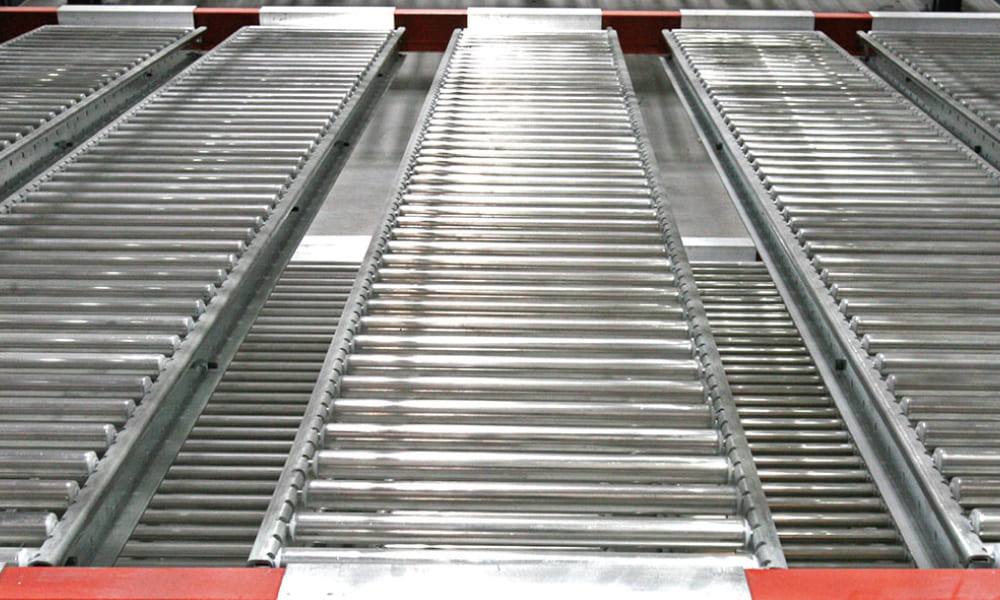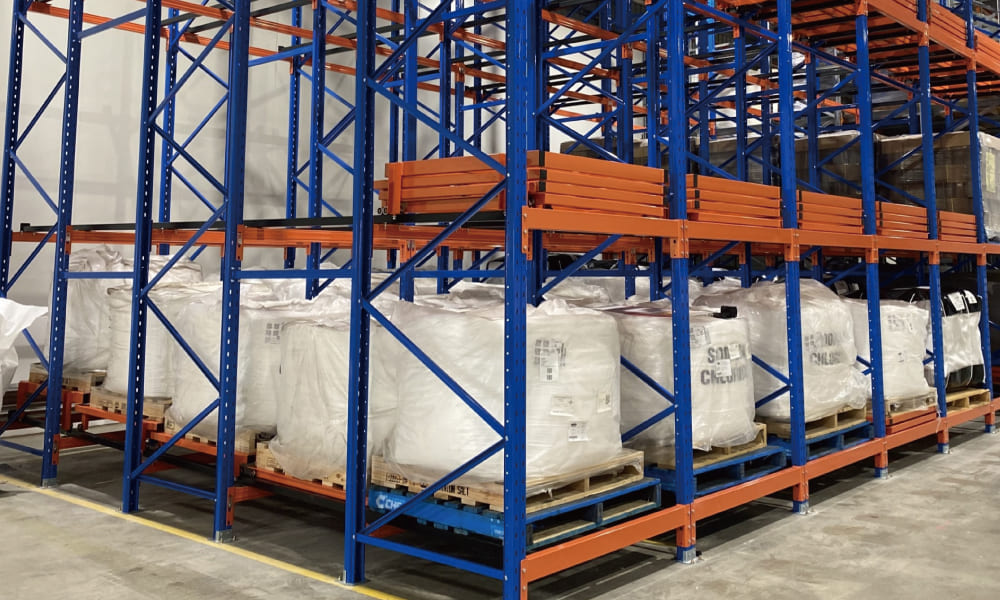تخزين البليت المباشر، تخزين عالي الكثافة حل، ليس من المستغرب أن يقدم طريقة فعالة لتحسين سعة المستودعات مع الحفاظ عليها
معدل تدفق المخزون. ولكن ما هو بالضبط التخزين المباشر للمنصات النقالة، وكيف يمكنه تحويل عمليات المستودع لديك؟
في هذا الدليل الشامل، سنستكشف خصوصيات وعموميات التخزين المباشر لمنصة التحميل، فوائدهوأنواعها واستراتيجياتها للمساعدة أنت تفهم السبب وراء تحول هذا النظام بسرعة إلى تغيير قواعد اللعبة في عالم الخدمات اللوجستية.

تخزين البليت المباشر يشير إلى نظام تخزين ديناميكي مصمم للتعامل مع حركة العناصر الثقيلة من خلال تمكين المنصات من التدفق بسلاسة على طول طبقة بكرات مائلة قليلاً.
يسمح هذا النظام بنقل البضائع من نهاية التحميل إلى نهاية التفريغ من خلال قوة الجاذبية، مما يقلل الحاجة إلى التعامل اليدوي. إنه حل مثالي للبيئات عالية الكثافة حيث يعد توفير المساحة والتحكم في معدل دوران المخزون من الأولويات الرئيسية.
ال نظام تخزين البليت المباشر يكون مفيدة بشكل خاص للشركات التي تتطلع إلى تحسين إدارة المخزون من خلال المنتجات سريعة الحركة. من خلال أتمتة تدفق المنتجات، يقلل التخزين المباشر للمنصات من الوقت المستغرق في المناولة والاسترجاع، مما يؤدي إلى تبسيط المستودع بأكمله عملية.
هناك نوعان أساسيان من تخزين البليت المباشر الأنظمة:

تم تصميم أنظمة تخزين البليت الحية باستخدام سرير دوار مائل قليلاً الذي يسمح للمنصات بالانزلاق من منطقة التحميل إلى نقطة الاسترجاع عبر الجاذبية. يمكن إعداد النظام لأي منهما FIFO (يدخل أولاً، يخرج أولاً) or LIFO (آخر ما يدخل، يخرج أولاً) العمليات.
في أنظمة FIFO، أول منصة نقالة تم تحميلها هي أول منصة يتم استرجاعها. يعد هذا مثاليًا للسلع أو المنتجات القابلة للتلف والتي لها تواريخ انتهاء الصلاحية، حيث مراقبة دوران المخزون أمر بالغ الأهمية. في أنظمة ليفو، آخر منصة تحميل تم تحميلها هي أول منصة تم استردادها، مما يجعلها أكثر ملاءمة للعناصر ذات العمر الافتراضي الأطول أو دوران المخزون الأقل تكرارًا.
الفوائد الرئيسية للتخزين المباشر لمنصة التحميل
نصائح عملية لتنفيذ التخزين المباشر لمنصة التحميل
عند التفكير في التحول إلى تخزين البليت المباشر، ضع هذه الاستراتيجيات في الاعتبار لتعظيم إمكانات النظام:
1. قم بتحليل احتياجات تدوير المخزون لديك: تحديد ما إذا كان إعداد FIFO أو LIFO يناسب منتجاتك بشكل أفضل. بالنسبة للسلع القابلة للتلف أو العناصر ذات العمر الافتراضي القصير، تعد أنظمة FIFO حاسمة، في حين أن LIFO تعمل بشكل جيد مع العناصر التي لا تتطلب دورانًا متكررًا للمخزون.
2. تحسين عرض الممر: تأكد من أن تخطيط المستودع الخاص بك يدعم التدفق السلس للمنصات. يمكن أن يساعدك تقليل عرض الممر لصالح التخزين الرأسي في تحقيق أقصى استفادة من المساحة المتوفرة لديك.
3. الاستفادة من الأتمتة: في حين أن التخزين المباشر للمنصات يستخدم الجاذبية للحركة الفعلية للمنصات، إلا أنه يمكنك التكامل حلول متنقلة مستقلة مثل الرافعات الشوكية الروبوتية أو أنظمة المكوك لتبسيط عملية التحميل والاسترجاع بشكل أكبر.
4. تقييم سعات التحميل: تأكد من رفوف تخزين البليت الخاصة بك قادرون على الدعم وزن وحجم المنصات الخاصة بك. يجب أن تكون الأسِرَّة الدوارة مجهزة للتعامل مع الأحمال المحددة التي تمر عبر المستودع الخاص بك.

التخزين المباشر لمنصة التحميل التي تغذيها الجاذبية هو الحل الأمثل للشركات التي تحتاج أول من يدخل، أول خروج (FIFO) دوران المخزون. يعد هذا النظام مفيدًا بشكل خاص للصناعات التي تتعامل مع السلع القابلة للتلف أو الأدوية أو العناصر التي لها تواريخ انتهاء الصلاحية، حيث يكون التحكم في معدل دوران المخزون أمرًا ضروريًا.

التخزين المباشر لمنصة الدفع للخلف تم تصميمه ل آخر ما يدخل، يخرج أولاً (LIFO) العمليات، مما يجعلها مناسبة للشركات التي لديها سلع أو عمليات غير قابلة للتلف حيث يسود عدد وحدات SKU على حجم كل SKU. يتيح هذا النظام مرونة أكبر في التحميل والاسترجاع، حيث تتم كلتا العمليتين من نفس الجانب من الحامل.
في بعض الحالات، قد تتطلب المستودعات حلاً مختلطًا حيث يتم كلا الأمرين يصرف أولاً و ليفو يتم تنفيذ الأنظمة معًا لتلبية احتياجات المخزون المختلفة. على سبيل المثال، يمكن استخدام المستودع التخزين المباشر للبليت الذي يتغذى بالجاذبية للمواد القابلة للتلف على جانب واحد، أثناء الاستخدام أرفف الدفع للخلف للسلع غير القابلة للتلف أو بطيئة الحركة.
خاتمة
أبحث لنقل المستودع الخاص بك إلى المستوى التالي؟ يستكشف تخزين البليت المباشر اليوم وتجربة فوائد زيادة جرد التحكم، الاستخدام الأمثل للمساحة، وتعزيز الكفاءة.
1. ما هي الصناعات التي تستفيد أكثر من التخزين المباشر لمنصة التحميل؟
تجد الصناعات ذات احتياجات التخزين كبيرة الحجم، مثل الأطعمة والمشروبات والأدوية وتجارة التجزئة والتصنيع تخزين البليت المباشر مفيدة بشكل خاص. يمكن للشركات التي تتعامل مع السلع القابلة للتلف ضمان دوران المخزون بكفاءة، في حين يمكن للشركات التي لديها أعداد كبيرة من SKU إدارة المخزونات الكبيرة دون شغل مساحة زائدة.
2. كيف يمكن مقارنة التخزين المباشر لمنصة التحميل مع حلول التخزين الأخرى؟
بالمقارنة مع غيرها أنظمة التخزين يحب ASRS (أنظمة التخزين والاسترجاع الآلية) أو أرفف البليت التقليدية، يوفر التخزين المباشر للبليت حلاً أكثر وضوحًا وفعالية من حيث التكلفة لإدارة المخزون الديناميكي. يتطلب طاقة واستثمارات أقل مقارنة ب بالكامل التخزين الآلي الأنظمة مع الاستمرار في توفير فوائد كبيرة في توفير المساحة والكفاءة التشغيلية.
حقوق النشر
© 2024 Jiangsu Vijing Logistics Technology Co., Ltd. كل الحقوق محفوظة.
 الشبكة المدعومة
الشبكة المدعومة
خريطة الموقع | المدونة | Xml | سياسة الخصوصية